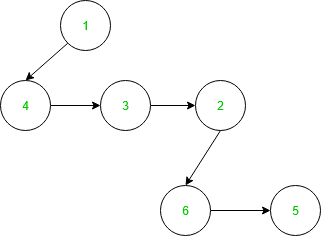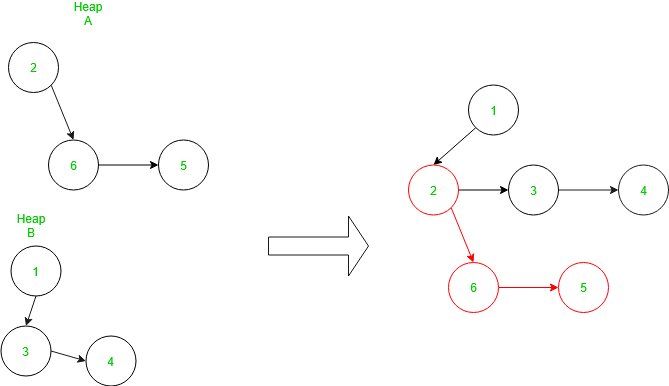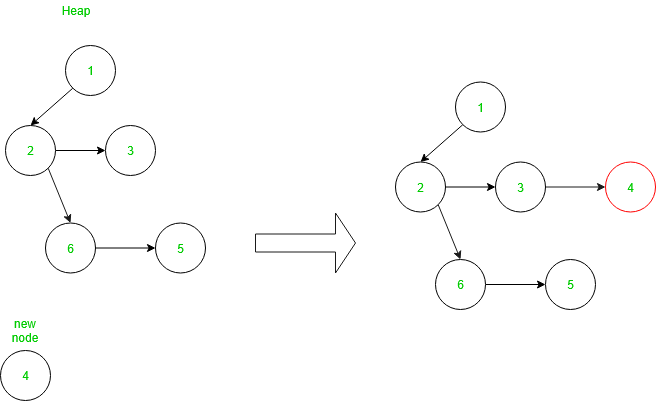配对堆就像简化形式的斐波那契堆。它还维护最小堆的属性,该属性的父值小于其子节点值。可以将其视为自调整二项式堆。
每个节点都有一个指向左子节点的指针,左子节点指向子节点的下一个兄弟节点。
配对堆的示例如下: 
加入或合并配对堆
要加入两个堆,首先,如果第一个堆的根节点小于第二个堆的根节点,则我们比较堆的根节点,然后第二个堆的根节点成为该根堆的左子节点第一个堆,反之亦然。该过程的时间复杂度为O(1)。
合并示例如下: 
在配对堆中插入:
要在堆中插入新节点,请创建一个新节点,并将其与现有堆合并,如上所述。因此,此函数的时间复杂度为O(1)。
插入示例如下: 
配对堆中的删除:
配对堆中的删除仅发生在根节点上。首先删除根,左子代与左子代的所有同级之间的链接。然后合并通过两次通过方法分离左孩子和所有兄弟姐妹而获得的树子树,并删除根节点。一次通过从左到右合并分离的子树,然后从右到左合并子树以形成新的堆,而不会违反min-heap的条件。此过程花费O(log n)时间,其中n是节点数。
删除示例如下: 
下面是上述方法的实现:
#include
using namespace std;
// Heap structure
struct HeapNode {
int key;
HeapNode *leftChild;
HeapNode *nextSibling;
HeapNode():
leftChild(NULL), nextSibling(NULL) {}
// creates a new node
HeapNode(int key_, HeapNode *leftChild_, HeapNode *nextSibling_):
key(key_), leftChild(leftChild_), nextSibling(nextSibling_) {}
// Adds a child and sibling to the node
void addChild(HeapNode *node) {
if(leftChild == NULL)
leftChild = node;
else {
node->nextSibling = leftChild;
leftChild = node;
}
}
};
// Returns true if root of the tree
// is null otherwise returns false
bool Empty(HeapNode *node) {
return (node == NULL);
}
// Function to merge two heaps
HeapNode *Merge(HeapNode *A, HeapNode *B)
{
// If any of the two-nodes is null
// the return the not null node
if(A == NULL) return B;
if(B == NULL) return A;
// To maintain the min heap condition compare
// the nodes and node with minimum value become
// parent of the other node
if(A->key < B->key) {
A->addChild(B);
return A;
}
else {
B->addChild(A);
return B;
}
return NULL; // Unreachable
}
// Returns the root value of the heap
int Top(HeapNode *node) {
return node->key;
}
// Function to insert the new node in the heap
HeapNode *Insert(HeapNode *node, int key) {
return Merge(node, new HeapNode(key, NULL, NULL));
}
// This method is used when we want to delete root node
HeapNode *TwoPassMerge(HeapNode *node) {
if(node == NULL || node->nextSibling == NULL)
return node;
else {
HeapNode *A, *B, *newNode;
A = node;
B = node->nextSibling;
newNode = node->nextSibling->nextSibling;
A->nextSibling = NULL;
B->nextSibling = NULL;
return Merge(Merge(A, B), TwoPassMerge(newNode));
}
return NULL; // Unreachable
}
// Function to delete the root node in heap
HeapNode *Delete(HeapNode *node) {
return TwoPassMerge(node->leftChild);
}
struct PairingHeap {
HeapNode *root;
PairingHeap():
root(NULL) {}
bool Empty(void) {
return ::Empty(root);
}
int Top(void) {
return ::Top(root);
}
void Insert(int key) {
root = ::Insert(root, key);
}
void Delete(void) {
root = ::Delete(root);
}
void Join(PairingHeap other) {
root = ::Merge(root, other.root);
}
};
// Driver Code
int main(void) {
PairingHeap heap1, heap2;
heap2.Insert(5);
heap2.Insert(2);
heap2.Insert(6);
heap1.Insert(1);
heap1.Insert(3);
heap1.Insert(4);
heap1.Join(heap2);
cout << heap1.Top() << endl;
heap1.Delete();
cout << heap1.Top() << endl;
cout<< (heap1.Empty()?"True":"False");
return 0;
}
输出:
1
2
False